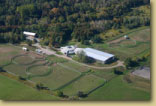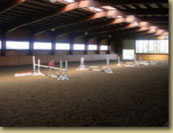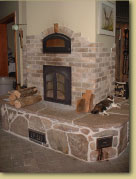ARCHIVE EQUINE NEWS STORIES
| Current news is available at TheHorsePortal.ca, Equine Guelph's online learning platform for practical, quick learning. Given the vast amount of information on horse health and welfare, Equine Guelph has archived its past news articles from 2002-2020. They are listed below, along with a search function available to find specific healthcare topics. | |
WELCOME TO HOP HILL STABLE Part TwoOctober 2010
By Nadine Abrams
 In part one, Hop Hill Stable, owned and operated by Mr. Jewett and his family, was highlighted for its unique approach to using recycled materials for the construction of a horse stable and indoor riding arena. From straw bale filled walls to salvaged materials from building demolitions around the province, we showcased Hop Hill Stable as an excellent example of how a horse facility can reduce its environmental ‘hoof’ print.
In part one, Hop Hill Stable, owned and operated by Mr. Jewett and his family, was highlighted for its unique approach to using recycled materials for the construction of a horse stable and indoor riding arena. From straw bale filled walls to salvaged materials from building demolitions around the province, we showcased Hop Hill Stable as an excellent example of how a horse facility can reduce its environmental ‘hoof’ print.
We want to take you back to Hop Hill Stable again to talk a little more about the hexagonal barn, tack room, and circular paddock construction. “We have looked back to the [original use] of our land as a traditional farm for inspiration,” says Jewett. The farm was first settled by Nimrod Case in 1850. Case and his family grew hops, a key ingredient in the making of beer, which led to the logical formation of the name Hop Hill. While use of the land at Hop Hill has changed from the Case homesteading days, Jewett is committed to preserving the human history of the site and references to its first settlers. “Protecting and preserving the environmental health of the property is really no different then what we do to ensure we protect the cultural history of the site. I see them as intrinsically linked,” says Jewett.
The Case family homestead once stood where the tack room is now and some of the original brick of that home has been incorporated around the door and in the foundation. The original masonry stove is at the heart of the tack room. The stove is so efficient that once lit, wood is only added once or twice in a 24 hour period. It keeps riders warm even on the coldest of winter days. The wood for the stove is stored just outside the tack room doorway on the original barrel racking rails salvaged from the old Joseph Seagram Distillery in Waterloo.
 A 60 x 30 metre indoor riding arena links directly to this tack room. The construction of the ring was completed using wood from, again, the Seagram’s facility as well as, large salvaged steel beams from an old General Motors plant in Oshawa. The beams were dismantled, individually trucked to the farm, cleaned-up and reassembled on new concrete footings. The windows in the arena are from the inner departure circle of Pearson Airport’s Terminal 1 building. The glass was removed from this location, re-cut as necessary and moved to Hop Hill. The awning over the north end window and a customs hall bench seat, which now sits on the viewing deck, was also salvaged from Terminal 1.
A 60 x 30 metre indoor riding arena links directly to this tack room. The construction of the ring was completed using wood from, again, the Seagram’s facility as well as, large salvaged steel beams from an old General Motors plant in Oshawa. The beams were dismantled, individually trucked to the farm, cleaned-up and reassembled on new concrete footings. The windows in the arena are from the inner departure circle of Pearson Airport’s Terminal 1 building. The glass was removed from this location, re-cut as necessary and moved to Hop Hill. The awning over the north end window and a customs hall bench seat, which now sits on the viewing deck, was also salvaged from Terminal 1.
 The use of the three R’s doesn’t stop with the buildings. Mr. Jewett is also conscious of the space used by the horses and applies the same principles to their health and comfort as he does to their human counter parts. The farm has incorporated circular horse paddocks which prevent dominant horses from cornering and placing stress on those less dominant. The circular paddocks mirror the hexagonal shaped barn which is thought to bring more comfort to horses then a traditional linear design. It allows them the opportunity to see each other like they would in a herd. This hexagonal design also takes advantage of breezes that come from every direction, improving the overall ventilation naturally. The large skylight, stall windows and multiple doors provide natural light all day thus reducing the need for electrical lighting.
The use of the three R’s doesn’t stop with the buildings. Mr. Jewett is also conscious of the space used by the horses and applies the same principles to their health and comfort as he does to their human counter parts. The farm has incorporated circular horse paddocks which prevent dominant horses from cornering and placing stress on those less dominant. The circular paddocks mirror the hexagonal shaped barn which is thought to bring more comfort to horses then a traditional linear design. It allows them the opportunity to see each other like they would in a herd. This hexagonal design also takes advantage of breezes that come from every direction, improving the overall ventilation naturally. The large skylight, stall windows and multiple doors provide natural light all day thus reducing the need for electrical lighting.
Stay tuned for the final article in this series on Hop Hill Stables. We will be discussing how the farm manages their manure and how you, like the Jewett’s, can secure funding to help you with your farm projects.
Contact your local Conservation Authority as they may be able to provide further funding and technical assistance for your environmental project. Not sure which of the 36 Conservation Authorities you should contact, check out the provincial map and contact listing on the Conservation Ontario website.
This article has been prepared by the Healthy Lands for Healthy Horses Steering Committee, which is comprised of representatives from the Horse Facilities Council, Uxbridge Horseman’s Association, Ontario Trail Riders Association, Equine Guelph, University of Guelph, Ontario Ministry of Agriculture, Food and Rural Affairs, Ontario Equestrian Federation and various Conservation Authorities. Funding for events organized by this committee has been provided by the Ontario Soil and Crop Improvement Association from the Nutrient Management BMP Demonstration Grant funding project.
For more information please visit: Healthy Lands for Healthy Horses website.